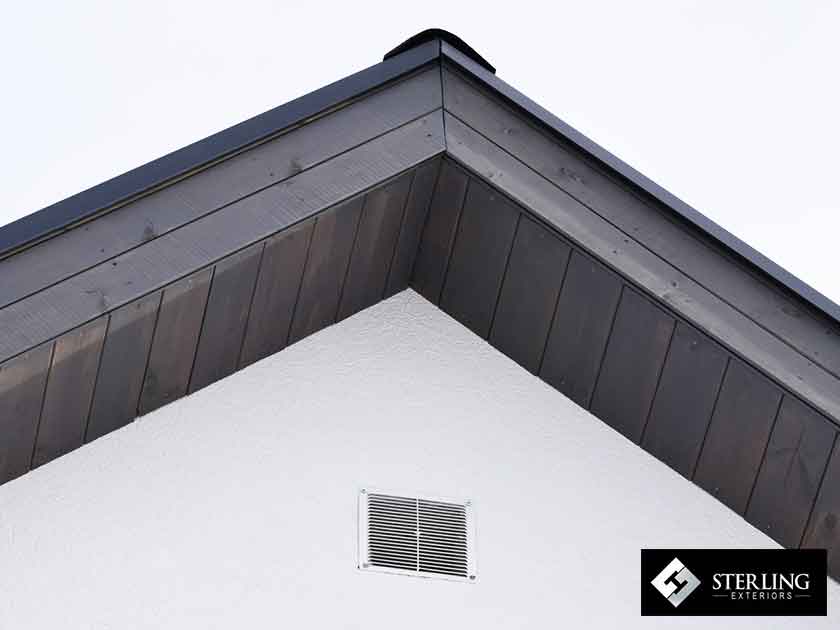The fascia runs along the roofline, joining the ends of trusses and rafters. It holds your gutters in place and can affect the overall look of your property. It’s important to keep it in good condition to avoid moisture-related issues inside and outside your home.

Here’s what typically causes fascia rot, what you can do about it and how to prevent it.
Why Is the Fascia Important?
Fascia is usually made from PVC, which is attractive and easy to maintain. You can get it in a wide range of styles. Your roofing contractor can lay the fascia flatly onto the wall or roof, square-edged or bull-nosed.
The fascia prevents moisture from penetrating the roof and your living space. In some cases, it supports the last row or slates and tiles as well. It gives your roof a more finished look, making it more pleasing to the eye. Taking care of your fascia means keeping your roof and interior safe from water damage.
What Causes Fascia Rot?
Improper Gutter Installation
Fascia rot can occur for various reasons, but improper installation of the gutters and overhang is a top cause. Both of these components are designed to divert water away from your roof and home. That is why improper gutter and overhang installation can lead to serious consequences later, such as extensive water damage. When they don’t function properly or fail to do their job, water can reach your fascia and cause the material to eventually rot. You can easily avoid these issues by working with a reliable roofing company.
Problems With Your Gutter System
Your fascia attached to your gutters, so if you have clogged or deteriorating gutters, the fascia will likely suffer from moisture-related issues like rot and mold. Over time, dried leaves, twigs and other debris can get stuck in your gutters, resulting in clogs. Clogged gutters will cause rainwater to overflow and reach the fascia. The same thing happens when your gutter system can’t handle the amount of rainwater in your area.
Storm Damage
The fascia tends to get exposed to moisture during rainstorms because of its location. This is the reason it can easily develop water damage following an extreme weather event. To prevent substantial damage to your fascia and other roofing components, be sure to contact a professional for an inspection after a serious storm. If repairs are necessary, you should try to address them immediately.
Poor Roof Installation
Another common cause of fascia rot is improper roof installation. Mistakes with the construction of a roofing system can lead to shingle damage, which can then cause water to drip down your fascia and exterior walls. Eventually, excessive exposure to water will lead to rot and deterioration of your fascia.
What Are the Common Signs of Fascia Rot?
Water in Your Basement
The presence of water in your basement, crawlspace and other low-lying areas is an indication that your fascia is in bad shape. Aside from having your fascia repaired or replaced, you should also have your property inspected by an experienced home inspector. This will determine if your home needs additional repairs.
Imperfections on the Fascia’s Surface
Roofing experts suggest regularly checking the fascia boards for indications of damage like splinters, cracks and discoloration. Once the fascia has been compromised, it won’t take long before the rotten boards start pulling away from your home.
How Can You Protect Your Fascia?
Schedule Routine Inspections and Maintenance
Regular inspections and maintenance can prolong the life of your roof, helping you avoid issues such as roof leaks, interior water damage and rotten fascia. Keeping your roof and fascia in good condition helps maintain your home’s comfort and structural integrity. Be sure to hire a dependable contractor to care for your roofing system.
Install a Drip Edge
A drip edge helps fascia boards stay in good condition. This component is an L-shaped piece of metal that roofers attach to the decking. You’ll find it just below the first layer of shingles, safely diverting water away from the fascia.
Invest in a Highly Water-Resistant Product
For your fascia board, you want to get the most water- and decay-resistant material that fits your budget. An experienced installer will not nail a fascia near the end of the grain because it makes the board more likely to split.
Once the board splits, water will easily penetrate the board and cause it to rot. Using the right type of nails and painting the board’s edges can help make it more structurally stable. Doing so keeps the exposed parts of the fascia protected from excessive moisture.
Ensure Proper Gutter Installation
Proper gutter installation is essential to preventing water damage in your fascia and the rest of your home’s exterior. An inefficient gutter system can cause water to back up to the roof and overflow to the siding. When it fails to direct water at a safe distance from your home, damage can occur in your basement and foundation. Another issue it can cause is erosion in your landscaping.
Have Your Gutters Cleaned Regularly
Clogged gutters are among the most common culprits behind roof damage. Over time, water backing up on your roof and fascia will result in the need for costly repairs. It can even shorten the lifespan of your roof.
Debris-filled gutters can draw the attention of pests and small animals that can endanger the health of your household. They can also use your gutters as an entry point to your roof or living spaces. Routine gutter cleaning and maintenance can help keep these pests away from your home.
Besides your fascia, an efficient gutter system will also protect the value of your home. If you are thinking about selling your home in the future, be sure to address gutter issues as soon as possible and keep up with maintenance.
For your residential roofing needs, Sterling Exteriors is always here to help. Give us a call at (513) 685-8055 or fill out our contact form for a free, no-obligation quote. We serve clients in Cincinnati, Loveland and Newton, OH.






